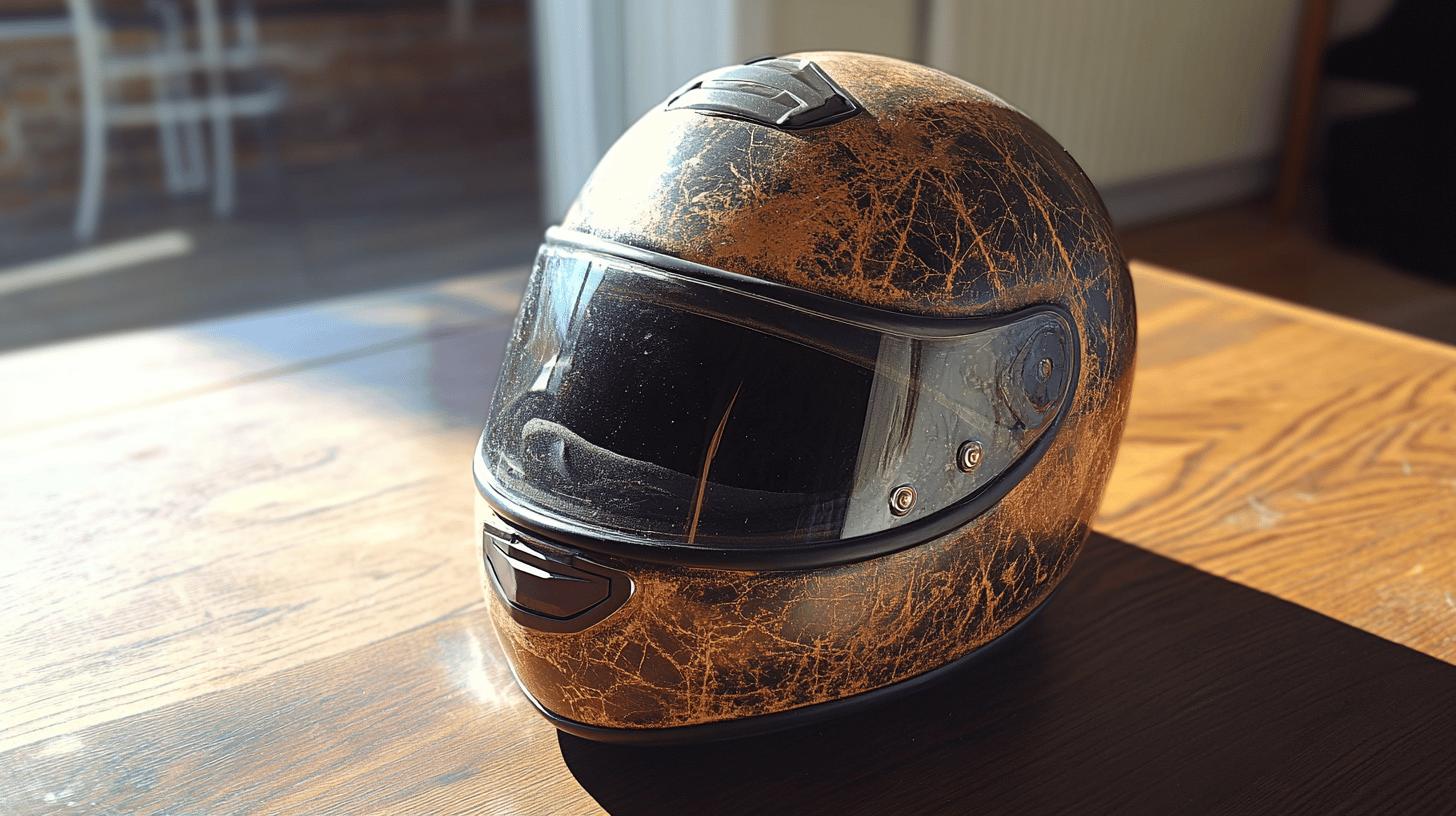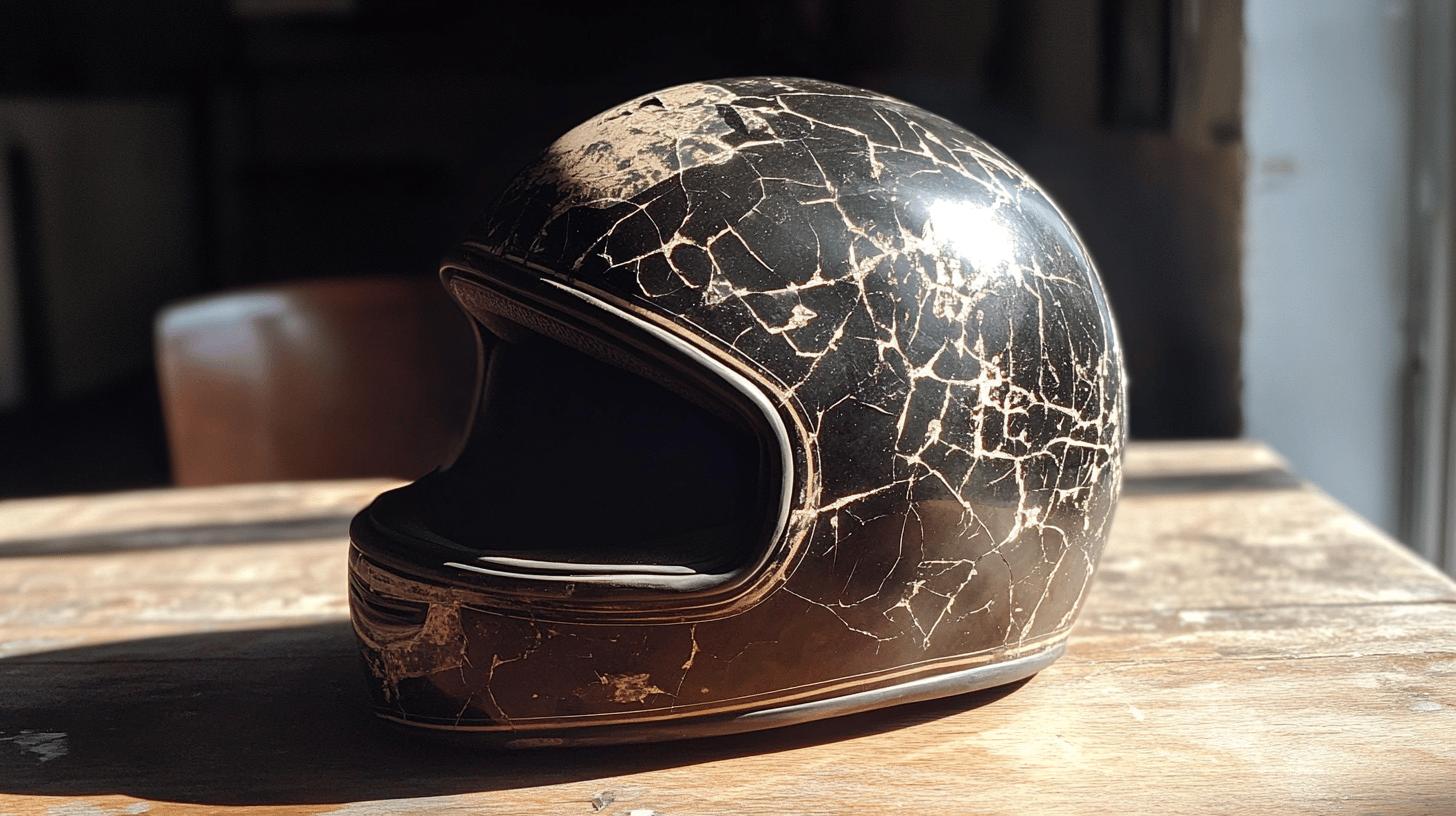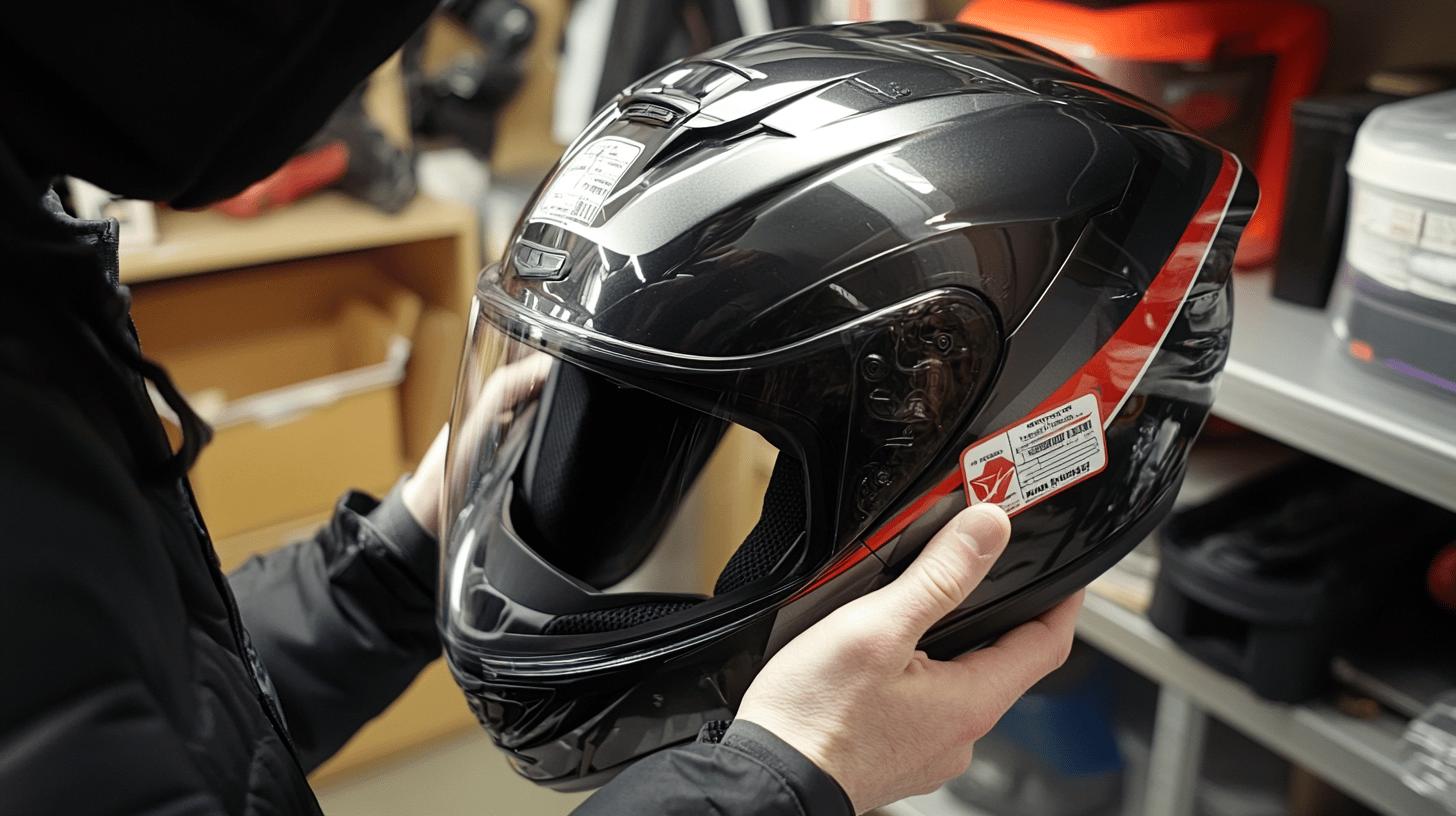Is your motorcycle helmet truly protecting you, or are you unknowingly risking your safety with outdated headgear?
When it comes to helmet replacement, the general recommendation is every five years, regardless of how frequently it’s worn. But what about those helmets that sit unused most of the year? Ignoring this guidance could mean compromising on vital protection due to material degradation over time.
This article delves into the critical aspects of helmet lifespan, identifying key indicators for replacement and how to choose an appropriate new helmet to ensure your safety.
Understanding the Lifespan of a Motorcycle Helmet

Motorcycle helmets should be replaced every five years. Why five years? The materials used in helmets, like polystyrene foam and adhesives, degrade over time due to environmental exposure and material fatigue, regardless of usage.
This degradation reduces the helmet's ability to absorb impact effectively, making it less protective in an accident. Therefore, observing this expiration date is a critical safety measure to ensure that the helmet still complies with safety standards and offers optimal protection.
The lifespan of a helmet is affected by several factors beyond the five-year guideline. The quality of the materials significantly impacts durability; helmets constructed from high-grade materials such as carbon fiber or Kevlar may exhibit prolonged lifespan.
The frequency of use also plays a role, as helmets used regularly will experience faster wear. Environmental exposure, including UV rays, moisture, and temperature extremes, can hasten material breakdown. Additionally, how a helmet is stored can influence its longevity, with improper storage leading to premature degradation.
-
Material Quality: Higher-grade materials increase lifespan.
-
Frequency of Use: Frequent use accelerates wear.
-
Environmental Exposure: Sunlight, moisture, and temperature can degrade materials.
-
Storage Conditions: Improper storage can lead to faster degradation.
-
Age: Helmets, even if unused, should be replaced after five years.
Signs It's Time to Replace Your Motorcycle Helmet

Visible damage is a crucial indicator that a motorcycle helmet needs replacement. What are the most obvious signs of helmet wear and tear? Cracks or deep scratches on the helmet's outer shell significantly compromise its structural integrity, reducing its ability to protect the head effectively during an impact.
These damages can result from accidental drops or collisions. Even minor surface abrasions, if extensive, suggest significant wear over time. When such physical damage is detected, replacing the helmet ensures continued safety.
What are less obvious indicators that a helmet needs replacing? Unpleasant odors or the degradation of interior linings are signs to watch for. Helmets may develop persistent odors due to sweat and moisture, leading to bacterial growth.
The breakdown of interior padding not only affects comfort but also compromises the helmet's fit and shock absorption capabilities. If a helmet's lining begins to deteriorate, losing shape or becoming compressed, it's a clear sign that a new helmet is required.
Why is it critical to replace a helmet after an accident? Helmets should be replaced immediately if involved in an accident, regardless of visible damage.
The internal structure, such as the foam liner, may suffer from impact forces, rendering it ineffective in future incidents. Helmets are designed to absorb energy during a single impact; thus, any involvement in an accident necessitates immediate replacement to maintain protective capabilities.
| Sign | Reason for Replacement |
|---|---|
| Visible Cracks | Compromises structural integrity |
| Deep Scratches | Suggests significant wear or damage |
| Unpleasant Odors | Indicates bacterial growth and interior degradation |
| Deteriorated Lining | Reduces fit and shock absorption |
Factors Affecting Helmet Replacement Frequency

How does exposure to elements impact how often a motorcycle helmet should be replaced? Regular exposure to extreme weather conditions, including UV rays, moisture, and temperature fluctuations, can accelerate the degradation of helmet materials.
The outer shell, typically made from materials like fiberglass or carbon fiber, may become brittle and less effective at impact absorption. Additionally, UV radiation can weaken materials over time, reducing the helmet's protective capabilities. Riders frequently exposed to harsh environmental conditions should consider replacing their helmets more often than the standard five-year guideline.
What usage habits necessitate more frequent helmet replacement? Frequent use and sharing of helmets can increase wear and tear, necessitating more frequent replacement. Helmets used on a daily basis are subject to constant stress, which can lead to faster degradation of both the exterior shell and interior padding.
Shared helmets experience additional wear from varying head shapes and sizes, as well as increased exposure to sweat and oils, which can degrade materials more rapidly. Consequently, helmets that are frequently used or shared should be replaced more often to maintain optimal safety.
-
Extreme Weather Exposure: UV rays and moisture accelerate material degradation.
-
Frequent Use: Regular use increases wear and tear.
-
Shared Use: Additional wear from shared use shortens lifespan.
-
Improper Storage: Poor storage conditions can lead to faster degradation.
-
Helmet Age: Even unused, helmets should be replaced after five years.
The Role of Safety Standards in Helmet Replacement

How do evolving safety standards affect helmet replacement decisions? Helmets older than five years may not comply with current safety standards, necessitating their replacement. As technology advances and our understanding of impact dynamics improves, safety standards for helmets are updated.
These updates ensure that helmets provide the best possible protection in the event of an accident. Consequently, a helmet manufactured several years ago might lack the latest safety features or fail to meet newer testing criteria. Therefore, replacing helmets at appropriate intervals aligns with these evolving standards, ensuring the highest level of safety.
What role do organizations like DOT and Snell play in helmet safety standards? Trusted organizations such as the Department of Transportation (DOT) and the Snell Memorial Foundation establish guidelines and certifications for helmet safety. These organizations conduct rigorous testing to evaluate a helmet's ability to absorb impact and protect the rider.
Their certifications indicate a helmet's compliance with industry standards, assuring riders of its reliability in protective performance. In addition, if manufacturers issue recalls based on safety concerns, helmets must be replaced immediately. Adhering to these guidelines and certifications is crucial for maintaining optimal safety while riding.
Maintenance Tips to Extend Helmet Lifespan

Why is maintaining a motorcycle helmet crucial? Proper maintenance significantly extends the lifespan of a helmet, ensuring it provides maximum protection for as long as possible. Helmets are essential safety gear that can degrade over time due to environmental exposure and regular use.
By following maintenance tips, riders can avoid premature wear and tear, keeping the helmet in optimal condition. This can save money and ensure safety by delaying the need for frequent replacements.
What are the best techniques for cleaning a helmet? Cleaning a helmet involves more than just wiping down the exterior. Start by removing the interior padding, if possible, and wash it with mild soap and water to eliminate sweat and bacteria buildup.
Use a soft cloth or sponge to clean the helmet's outer shell with warm water and a gentle detergent, avoiding harsh chemicals that can damage the finish. For the visor, use a microfiber cloth to prevent scratches. Let all components air dry completely before reassembling to prevent mold or unpleasant odors.
How should helmets be stored to prevent degradation? Proper storage is critical in maintaining a helmet's structural integrity. Helmets should be stored in a cool, dry place away from direct sunlight, which can cause materials to degrade.
Avoid placing helmets on hard surfaces that might scratch or dent them. Consider using a helmet bag for added protection against dust and accidental impacts. Ensuring helmets are not exposed to extreme temperature fluctuations will also help maintain their durability.
-
Regular Cleaning: Wash interior padding with mild soap; clean the shell with a soft cloth.
-
Avoid Harsh Chemicals: Use gentle detergents to prevent damage to materials.
-
Proper Drying: Allow all parts to air dry completely before reassembly.
-
Cool, Dry Storage: Keep helmets away from direct sunlight and extreme temperatures.
-
Use a Helmet Bag: Protect helmets from dust and impacts during storage.
Choosing the Right Replacement Helmet

What is the most crucial aspect to consider when buying a new helmet? Comfort and fit are paramount. A helmet should provide even pressure around the head without uncomfortable pressure points. An ill-fitting helmet can be distracting and uncomfortable, potentially reducing safety by shifting during a ride.
To ensure the best fit, measure your head's circumference and consult the manufacturer's sizing chart. Try on various models to find one that fits snugly but comfortably, allowing for a secure and stable ride.
Why is it essential to select helmets that meet safety standards? Helmets must comply with established safety certifications such as DOT, ECE, or Snell to guarantee effective protection. These certifications indicate that the helmet has undergone rigorous testing for impact absorption and structural integrity.
Helmets from reputable brands ensure quality and reliability, providing riders with peace of mind. Safety features, material durability, and brand reputation should be prioritized when selecting a replacement helmet to ensure maximum protection on the road.
-
Comfort and Fit: Ensure the helmet fits snugly and comfortably.
-
Safety Certifications: Look for DOT, ECE, or Snell certification.
-
Material Durability: Opt for helmets with high-quality construction materials.
- Brand Reputation: Choose helmets from reputable companies for reliability.
Final Words
Replacing a motorcycle helmet every five years is advised due to material degradation and evolving safety standards. Indicators such as visible cracks or odors necessitate immediate replacement.
Exposure to elements or frequent use may require more frequent changes. Maintain helmets well to prolong use, but never compromise on safety.
Selecting a new helmet involves choosing quality brands and ensuring proper fit. Stay informed on safety standards for protection.
FAQ
How often do you need to replace a motorbike helmet?
A: Motorbike helmets should generally be replaced every five years, even if they haven't sustained visible damage, due to material degradation over time.
Should you replace a motorcycle helmet if you drop it?
A: A motorcycle helmet should be replaced if dropped, as the internal structure might have been compromised, reducing its effectiveness.
Do DOT motorcycle helmets expire?
A: DOT motorcycle helmets do not have an official expiration date, but it is recommended to replace them every five years to maintain safety standards.
What is the lifespan of a motorcycle helmet?
A: The typical lifespan of a motorcycle helmet is around five years, influenced by material quality and frequency of use.
Is a 10 year old motorcycle helmet safe?
A: A 10-year-old motorcycle helmet is not considered safe, as materials degrade over time and may not meet current safety standards.
How to tell if a motorcycle helmet is still good?
A: Check for visible damage, such as cracks or scratches, unpleasant odors, or any degradation of the internal padding to determine if a helmet is still good.
Do I really need to replace my helmet after 5 years?
A: Replacing a helmet after five years is advisable, as materials deteriorate and may not provide adequate protection.
Where is the motorcycle helmet expiration date location?
A: Helmets often have a manufacturing date printed inside, typically on a label or sticker, to help track their age.
What factors affect helmet replacement frequency?
A: Helmet replacement frequency is affected by exposure to extreme weather, frequency of use, and storage conditions.
Why is it necessary to adhere to safety standards when replacing helmets?
A: Adhering to safety standards is crucial, as evolving standards may render older helmets non-compliant and less protective.

Mark Anderson is a trusted expert with over 25 years of riding experience. At 56, his deep knowledge of long-distance touring and participation in major motorcycle rallies makes him a reliable source for gear recommendations on ProtectiveGearz. Mark’s decades of firsthand experience ensure his advice is authoritative and valuable to riders seeking expert guidance.



